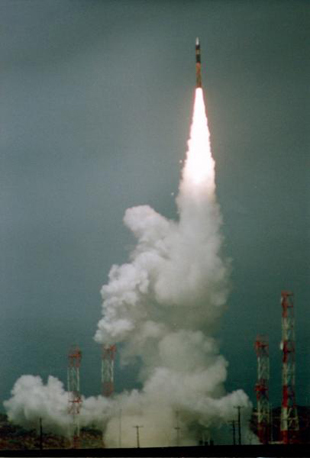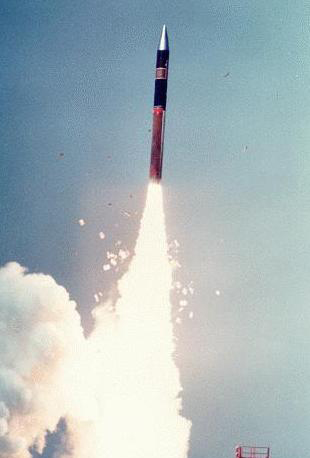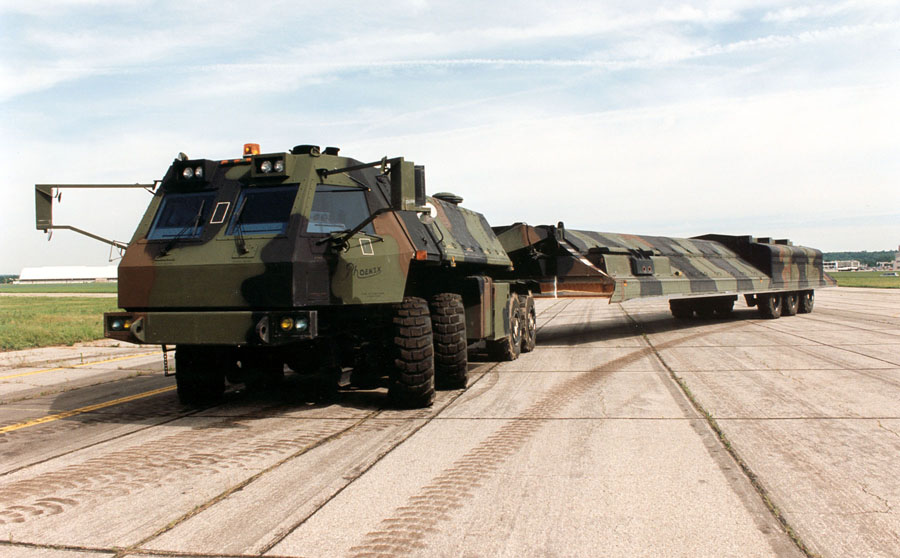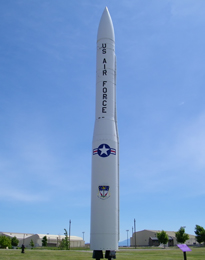
First SICBM Launch May 11, 1989

SICBM Launch
Small ICBM Missile
Shortly after President Ronald Reagan took office for his first term in 1980, his administration was saddled with what to do with the Peacekeeper missile, regarding the ongoing debate of how the LGM-118 Peacekeeper missile would be based. In January 1983, Reagan called for the formation of a special bipartisan committee to determine just how this missile was going to be based. Lieutenant General Brent Scowcroft, USAF, (ret) was tasked with forming what came to be known as the Scowcroft Committee.
That following April, 1983, the committee issued a report recommending the deployment of the Peacekeeper missile in modified Minuteman silos. Immediately following this deployment would be the development and deployment of a small, mobile ICBM. Thus the beginning of the SICBM, the MGM-134A missile, which was nicknamed "Midgetman" based on the Minuteman missile.
President Reagan endorsed the Scowcroft report on April 19, 1983. Congress quickly agreed with Reagan's endorsement and gave him their nod of approval on May 26, 1983. By the time Reagan was reelected in 1984, the SICBM missile had its basic characteristics outlined, and Reagan authorized the full scale development of the MGM-134A SICBM missile.
Due to the ongoing concern that the Minuteman and Peacekeeper missiles were so vulnerable in their fixed silos, the Reagan administration needed an accurate, mobile and silo killing ICBM to counter Russia's ICBM program with their SS-24 rail mobile ICBMs and their SS-25 road mobile ICBMs. In December 1986 President Reagan authorized full scale development of the SICBM. The contract went to Martin Marietta to design and build the missile.
The first launch of a prototype SICBM, which was unsuccessful, occurred May 11, 1989 at Vandenberg Air Force Base, California. The prototype achieved 70 seconds worth of flight before tumbling into the Pacific ocean. April 18, 1991 was the second and last launch of the SICBM. This second launch from Vandenberg AFB proved to be successful, and the missile reached its target in the Kwajalein Test Range.
The prototype tested in 1989 and 1991 stood 46 feet tall. Its diameter was approximately 3 feet 10 inches. Weight was 30,000 pounds. Like its predecessors, the MGM-134A had its 3 stage solid rocket boosters. Estimated range was 6800 miles, carrying an Mk-21 W87 reentry vehicle with a yield of 475 KT. This W87 RV was manufactured by the Avco Systems Division and had an approximate weight of 440 to 600 pounds.
The SICBM program was canceled in January 1992, due to President George Herbert Bush, who felt that there was no need for this mobile missile based on the reduction in strategic tensions of the Cold War during that time period. After a total of two launches, one successful, one not, the SICBM quickly faded into the background.
Hardened Mobile Launcher

As Martin Marietta was busy designing the MGM-134A Small ICBM missile, Boeing was given the contract to design and build the Hardened Mobile Launcher. This launcher, also known as the ETU, Engineering Test Unit, would enable the Air Force the ability to mobilize its SICBM. Its primary purpose was to transport and launch the SICBM.
The Air Force's plan was to have each HML contain one SICBM. The HML would be housed in various protective shelters, usually located within the missile field of its prospective Air Force missile base. Once nuclear tensions increased, each of these Hardened Mobile Launchers would become mobile and roam randomly along the roadways and highways, making it extremely difficult for the Soviet Union to target these SICBM missiles individually.
Boeing Aerospace designed and built the HML in conjunction with Loral Defense Systems Division. It was powered by a Rolls Royce Perkins diesel, putting out 1200 horsepower. The diesel drove all eight tractor wheels through a electro-hydraulic transmission.
The entire vehicle was over 110 feet long, and the tractor had a draw-pull capacity of over 80,000 pounds. The HML weighed over 239,000 pounds when fully loaded, and was capable of speeds up to 55 mph on a paved road, and off road this beast was capable of approximately 30 mph.
The HML was hardened and designed to withstand approximately 30 pounds of pressure in terms of a nuclear blast. The trailer came equipped with a trailer mounted plow, allowing the tractor to partially bury the launcher-trailer into the ground for both additional protection from a nuclear blast, as well as to prepare the HML to launch its missile.
Boeing delivered its final engineering model (pictured above) to the Air Force in 1988 and the HML was tested at Malmstrom Air Force Base, Montana until 1991.

